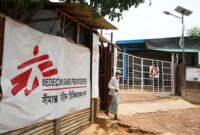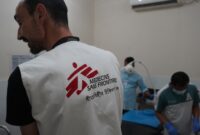The Rohingya Displacement Crisis
In August 2017, a coordinated campaign of violence by the Myanmar military against members of that country’s Rohingya ethnic minority drove hundreds of thousands of people to flee across Myanmar’s border with Bangladesh in search of safety.
More than five years later, close to one million Rohingya remain confined to a series of overcrowded refugee camps along a small stretch of land in Cox’s Bazar, Bangladesh. They cannot return safely to Myanmar, where the ruling military junta does not recognize them as citizens and is responsible for much of the violence against them. But they also cannot legally work, go to school or leave the increasingly untenable conditions of their camps in Bangladesh, which does not want them to remain permanently on its territory.
As a result, the Rohingya – who the United Nations has described as one of the most persecuted minorities in the world – are a stateless population. Those who remain in Myanmar are denied access to healthcare and other basic needs, have no freedom of movement and are at perpetual risk of violence. The nearly one million Rohingya living in the camps across the border in Bangladesh are entirely dependent on humanitarian assistance for survival. They have no pathway out of the dismal living conditions in which they find themselves trapped. The remaining members of the Rohingya community are similarly displaced, mostly across the wider region of southeast Asia, where as people who are stateless migrants they have little hope of settling legally, and routinely face persecution and exploitation.
Solutions need to recognize Rohingya’s fundamental humanity
Doctors Without Borders/Médecins Sans Frontières (MSF) has been providing medical humanitarian assistance for Rohingya communities in both Myanmar and Bangladesh for more than 30 years and is currently one of the largest providers of medical care for Rohingya refugees in Cox’s Bazar. (Prior to 2017, Bangladesh had already received earlier waves of displaced Rohingya fleeing violence in Myanmar.) We also continue to provide assistance to Rohingya communities in Myanmar, and to Rohingya migrants with no access to support services in Malaysia.
MSF sees first-hand the frequently miserable conditions in which many Rohingya communities are forced to live. Our patients in Cox’s Bazar are unable to leave their overcrowded refugee camps, where a lack of adequate water and sanitation measures leaves residents greatly exposed to waterborne diseases and dangerous skin infections. In addition to primary and secondary health and hospital services, MSF provides sexual and reproductive healthcare in Cox’s Bazar, and care for people affected by sexual and gender-based violence, which is at crisis levels within the camps. Exposure to high levels of violence has led to significant mental health needs among displaced Rohingya communities in Myanmar, Bangladesh and Malaysia, leading MSF to prioritize psychosocial services as part of our package of care.
We are also witnessing the impact, six years after the international community responded with concern to the mass displacement in 2017, of reduced levels of global attention to the Rohingyas’ plight. Multiple large and simultaneous international humanitarian emergencies have left the response to the Rohingya refugee crisis vying for resources from an overstretched humanitarian sector.
The lack of a clear path forward for displaced Rohingya communities, or any choice for them other than one between having no safety in Myanmar or no future anywhere else, make it difficult to effectively address their many needs. MSF is calling on all humanitarian donors and members of the international community to continue prioritizing the Rohingya displacement crisis as a humanitarian emergency, and work to find an effective short-term as well as longer-term solution that recognizes the Rohingyas’ fundamental humanity.
Why it matters to Canadians
When more than 700,000 Rohingya crossed the border from Myanmar to Bangladesh in a matter of days in August 2017, Canada’s government was among those who responded quickly to the rapidly evolving crisis, not only through financial support but also by taking the initiative to help organize and coordinate various political, diplomatic and humanitarian elements of the emergency response.
Canada’s contribution also included the decision to send a special envoy to Myanmar in October 2017 to assess the events that led to the initial crisis, and to engage with the authorities in Myanmar and Bangladesh, as well as with the Rohingya refugees themselves. The appointment of Bob Rae, currently Canada’s ambassador to the United Nations, to the special envoy role underscored the welcome seriousness with which Canada approached the Rohingya emergency.
The report Rae issued in 2018 concluded with a number of key recommendations to both Canada’s government and the international community, including critical and continued investment in humanitarian assistance and a call to welcome more Rohingya refugees to this country. In 2022, Canada announced that its response to the Rohingya crisis would be entering a new phase, which includes efforts to support the creation of safer conditions in Myanmar for all populations at risk, and the intent to appoint a new special envoy.
Canada can use political, diplomatic leverage
MSF is one of the world’s primary providers of humanitarian medical care to Rohingya communities, especially within the emergency response in Cox’s Bazar, Bangladesh. We have worked with Rohingya for more than three decades to address Rohingya health and humanitarian needs. As such, we welcome Canada’s continued engagement on the Rohingya refugee crisis, and the role Canada has played to help facilitate a more effective humanitarian response in Bangladesh.
But we also urge Canada to continue using its political and diplomatic leverage to prevent the situation for Rohingya refugees from becoming an unacceptable and inhumane status quo in which close to one million people remain trapped in indefinite limbo amid worsening health and living conditions. Given the ongoing violence, there currently exists no prospect of a safe return for Rohingya refugees to Myanmar in the immediate future, but the existence they face in an increasingly oppressive environment in Cox’s Bazar is equally untenable. Canada’s commitment to engaging stakeholders on the Rohingya emergency must include efforts to finding a solution to this impasse.
In its role as an important donor to the Rohingya refugee response in Bangladesh, Canada can also help ensure this crisis remains an international humanitarian priority, even as other global emergencies emerge. The refugees who remain stranded in Cox’s Bazar have no choice but to be completely dependent on humanitarian assistance, which means Canada and others must continue to provide food, water and sanitation, medical care, protection and other services to a degree that allows camp residents to live in safety, health and dignity.

















